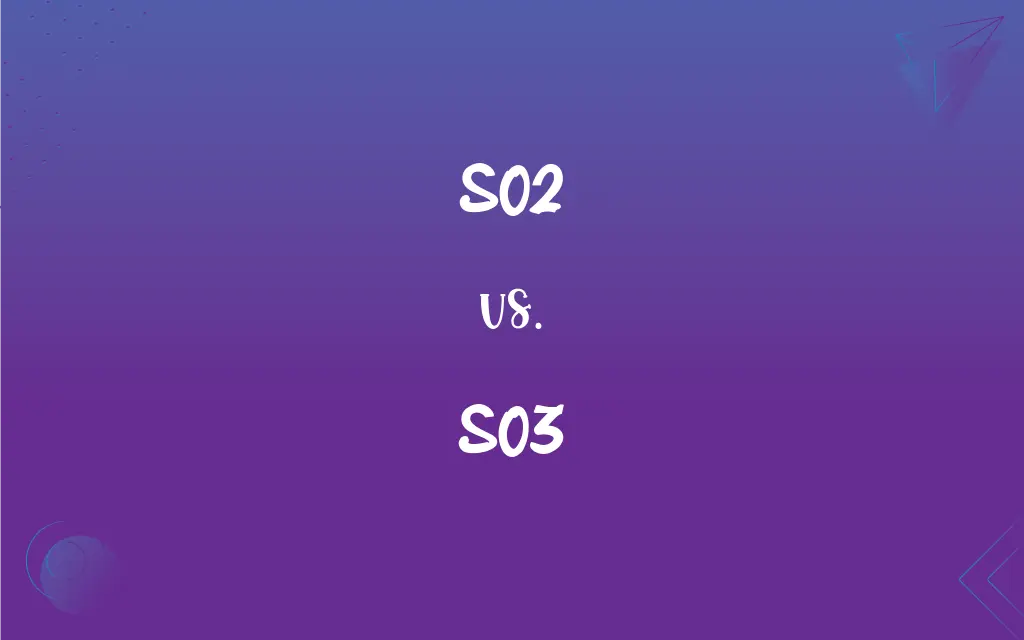SO2 vs. SO3: What's the Difference?
Edited by Harlon Moss || By Janet White || Published on March 15, 2024
SO2 refers to sulfur dioxide, a toxic gas with a pungent odor, while SO3 denotes sulfur trioxide, a highly reactive substance forming sulfuric acid upon contact with water.

Key Differences
SO2, or sulfur dioxide, is a chemical compound composed of sulfur and oxygen with a molecular formula of SO2. It is known for its pungent, irritating smell and is primarily produced by volcanic activities and industrial processes, such as the burning of fossil fuels. SO3, or sulfur trioxide, on the other hand, is another sulfur-oxygen compound with the formula SO3. Unlike SO2, sulfur trioxide has no odor and is a key intermediate in the industrial synthesis of sulfuric acid, one of the most important chemicals in the chemical industry.
Sulfur dioxide (SO2) plays a significant role in environmental chemistry as a precursor to acid rain when it reacts with water vapor in the atmosphere to form sulfuric acid (H2SO4). This reaction is not direct but involves a complex series of steps, with sulfur trioxide (SO3) often being an intermediate product in the formation of sulfuric acid. Therefore, the presence of SO3 is crucial for understanding the environmental impact of SO2 emissions.
In terms of health effects, SO2 is more directly associated with respiratory problems and irritation of the eyes, nose, and throat. It is a concern in urban and industrial areas where it can reach harmful concentrations. SO3, due to its tendency to rapidly react with water to form sulfuric acid, poses significant hazards in its own right, particularly in industrial settings where it is produced or used.
When it comes to regulatory standards and environmental monitoring, SO2 is more commonly measured and regulated due to its direct emissions into the atmosphere from sources like power plants and vehicles. SO3, while less commonly emitted in its pure form, is still of concern due to its role in acid rain formation and is monitored as part of efforts to control sulfuric acid aerosols in the atmosphere.
In industrial applications, the conversion of SO2 to SO3 is a critical step in the contact process for sulfuric acid production. This process highlights the industrial link between SO2 and SO3, where SO2, obtained from burning sulfur or roasting sulfide ores, is oxidized to SO3 in the presence of a catalyst. The SO3 is then absorbed in water to produce sulfuric acid, showcasing the transformation from a problematic pollutant to a valuable industrial product.
ADVERTISEMENT
Comparison Chart
Chemical Formula
Sulfur dioxide has the formula SO2.
Sulfur trioxide is represented by SO3.
Physical State
At room temperature, SO2 is a gas.
SO3 exists in several forms, but the most common is a colorless solid.
Odor
SO2 is known for its sharp, pungent odor.
SO3 is odorless, but it can rapidly form sulfuric acid, which has a sharp, pungent odor.
Environmental Impact
SO2 is a significant contributor to acid rain and air pollution.
SO3 directly forms sulfuric acid upon contact with water vapor, contributing to acid rain.
Industrial Use
SO2 is used in the production of sulfuric acid and as a preservative.
SO3 is crucial in the industrial synthesis of sulfuric acid through the contact process.
ADVERTISEMENT
SO2 and SO3 Definitions
SO2
SO2 is a chemical compound that consists of sulfur and oxygen.
The industrial plant emitted SO2 into the atmosphere.
SO3
SO3 is highly reactive, especially with water.
SO3 rapidly reacts with atmospheric moisture to form acid.
SO2
SO2 is used in the production of sulfuric acid.
The factory uses SO2 in its sulfuric acid production process.
SO3
SO3 can exist as a solid under normal conditions.
Solid SO3 was stored in a sealed container to prevent reaction with moisture.
SO2
SO2 can cause respiratory problems when inhaled.
Exposure to SO2 can aggravate asthma symptoms.
SO3
SO3 is produced industrially in the contact process.
The plant produces SO3 through the contact process for making sulfuric acid.
SO2
SO2 is primarily produced from burning fossil fuels.
Coal-fired power plants are a major source of SO2 emissions.
SO3
SO3 is a compound formed from sulfur and oxygen.
SO3 reacts with water to form sulfuric acid.
SO2
SO2 acts as a precursor to acid rain.
High levels of SO2 in the air can lead to acid rain.
SO3
SO3 contributes to acid rain formation more directly than SO2.
When SO3 enters the atmosphere, it can lead to acid rain.
FAQs
How does SO2 affect human health?
SO2 can irritate the respiratory system, causing coughing, throat irritation, and aggravation of asthma.
Can SO2 transform into SO3?
Yes, SO2 can oxidize to form SO3, a reaction that is significant in industrial processes and atmospheric chemistry.
What is SO3 and its significance?
SO3, or sulfur trioxide, is crucial in the production of sulfuric acid and contributes to acid rain when it reacts with water vapor.
What is SO2 and where does it come from?
SO2, or sulfur dioxide, is a gas primarily produced by burning fossil fuels and volcanic eruptions.
What are the environmental implications of SO2 and SO3?
Both contribute to acid rain, but SO3 forms sulfuric acid more directly, while SO2 requires oxidation to SO3 first.
What role does SO3 play in the atmosphere?
SO3 can form aerosols of sulfuric acid, impacting cloud formation and climate.
Are there any natural sources of SO3?
Natural SO3 production is less common than SO2, with most SO3 arising from anthropogenic sources or secondary atmospheric reactions.
How are emissions of SO2 regulated?
Many countries have regulations to limit SO2 emissions from industrial sources to protect air quality.
What is the main industrial use of SO2?
The main industrial use of SO2 is in the production of sulfuric acid and as a preservative in food and beverages.
How is SO3 managed in industrial settings?
SO3 is carefully managed due to its reactivity, often being neutralized to form sulfuric acid in controlled environments.
What measures are taken to control SO2 pollution?
Control measures include scrubbers in power plants, cleaner fuel sources, and regulatory limits on emissions.
How do volcanic eruptions impact levels of SO2 and SO3?
Volcanic eruptions can release significant amounts of SO2, which can then oxidize to form SO3 in the atmosphere.
How is SO3 produced industrially?
SO3 is produced industrially via the oxidation of SO2 in the presence of a catalyst, a key step in the contact process for sulfuric acid production.
What are the safety considerations for handling SO3?
Due to its reactivity, especially with water, SO3 must be handled with extreme care to prevent accidental release or contact with moisture.
How does acid rain from SO2 and SO3 impact ecosystems?
Acid rain can lower the pH of soil and water bodies, harming plant and aquatic life.
How does SO3 interact with water?
SO3 rapidly reacts with water to form sulfuric acid, a reaction that is exothermic and can be hazardous.
Can SO2 and SO3 coexist in the atmosphere?
SO2 and SO3 can coexist in the atmosphere, with SO2 often acting as a precursor to SO3 through oxidation processes.
What are the challenges in controlling SO3 emissions?
Controlling SO3 emissions is challenging due to its high reactivity and the need for efficient capture methods.
What technologies are used to monitor SO2 and SO3 levels?
Technologies include satellite sensors, ground-based monitoring stations, and chemical sensors for real-time analysis.
How does the conversion of SO2 to SO3 relate to acid rain?
The conversion of SO2 to SO3 in the atmosphere is a key step in the formation of acid rain, as SO3 readily forms sulfuric acid upon mixing with atmospheric moisture.
About Author
Written by
Janet WhiteJanet White has been an esteemed writer and blogger for Difference Wiki. Holding a Master's degree in Science and Medical Journalism from the prestigious Boston University, she has consistently demonstrated her expertise and passion for her field. When she's not immersed in her work, Janet relishes her time exercising, delving into a good book, and cherishing moments with friends and family.
Edited by
Harlon MossHarlon is a seasoned quality moderator and accomplished content writer for Difference Wiki. An alumnus of the prestigious University of California, he earned his degree in Computer Science. Leveraging his academic background, Harlon brings a meticulous and informed perspective to his work, ensuring content accuracy and excellence.































































